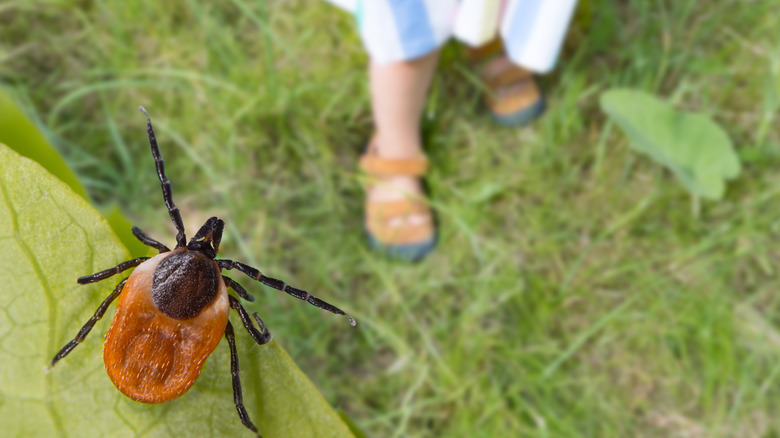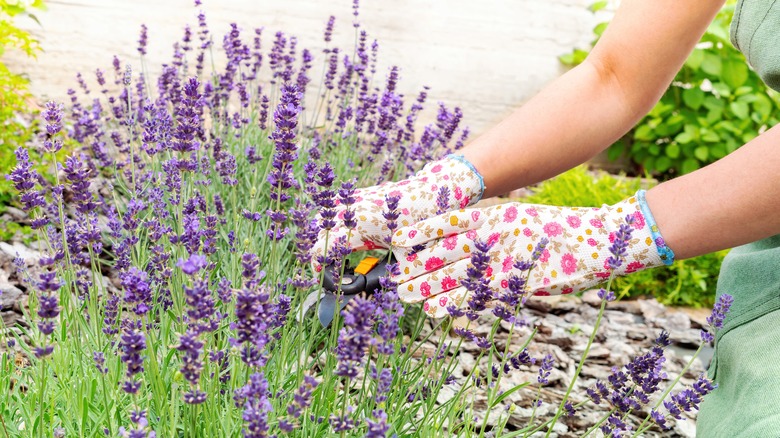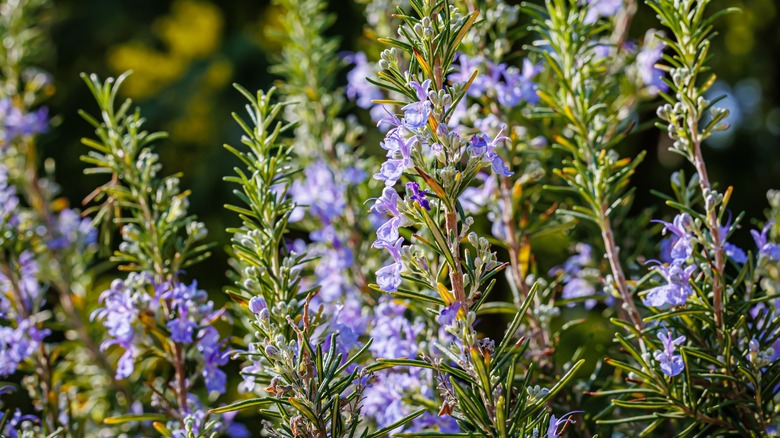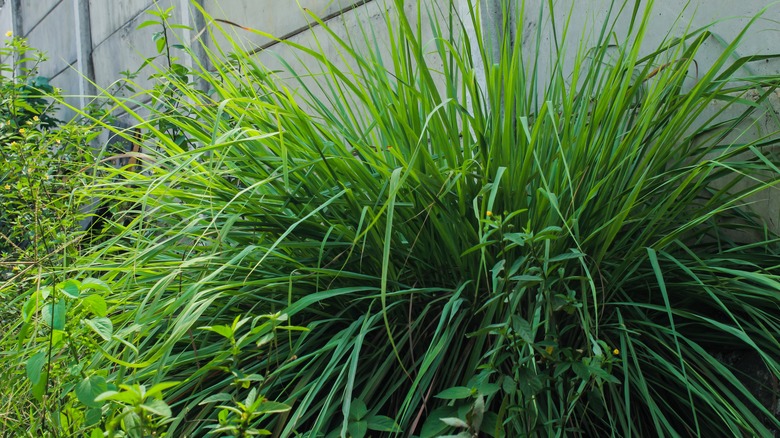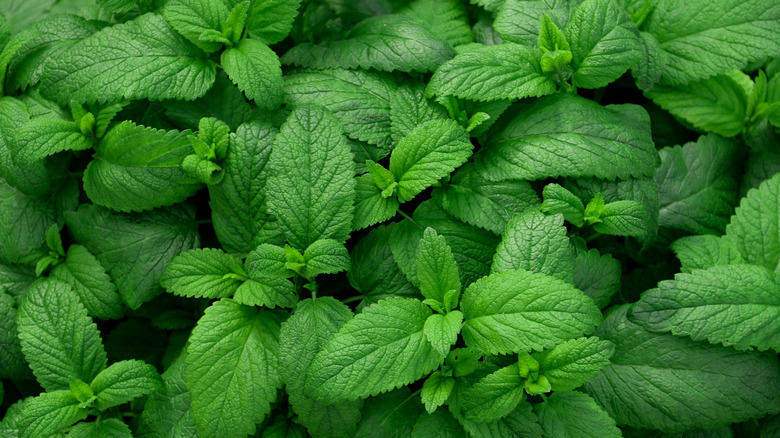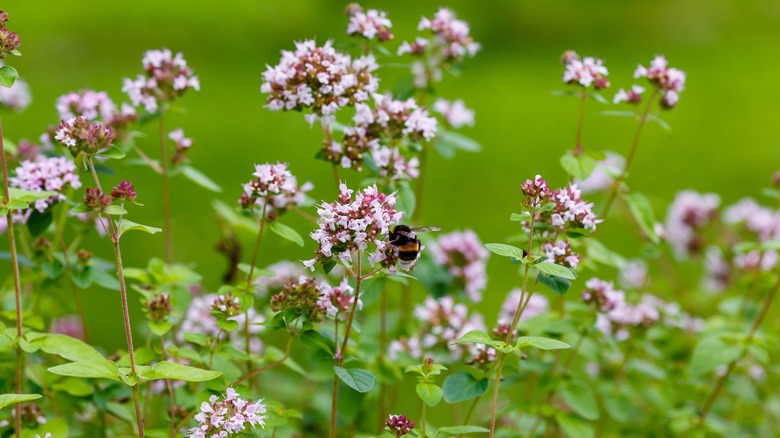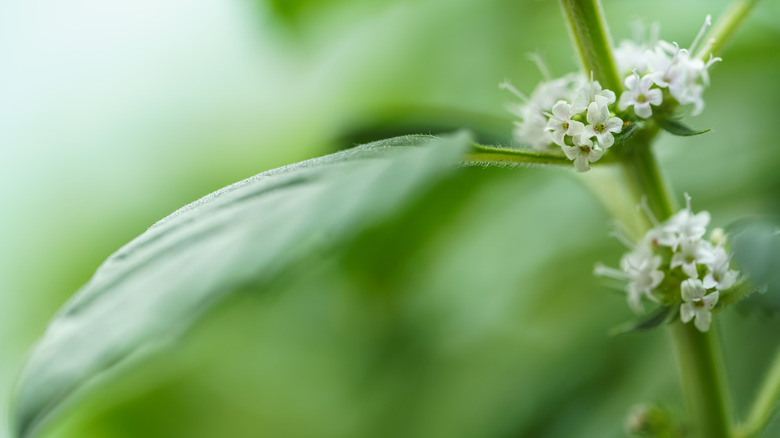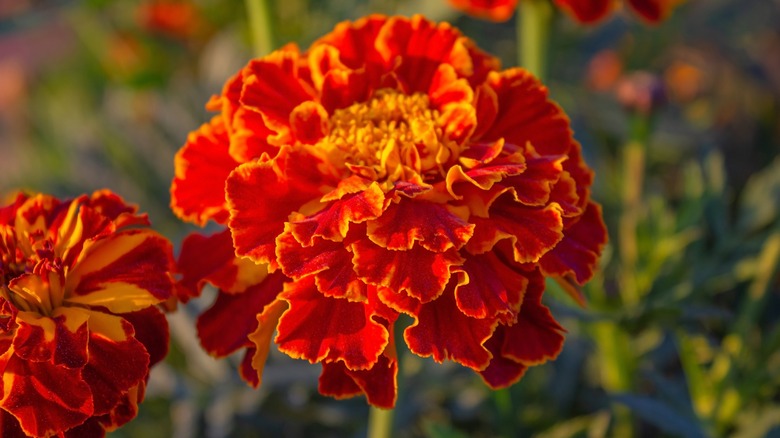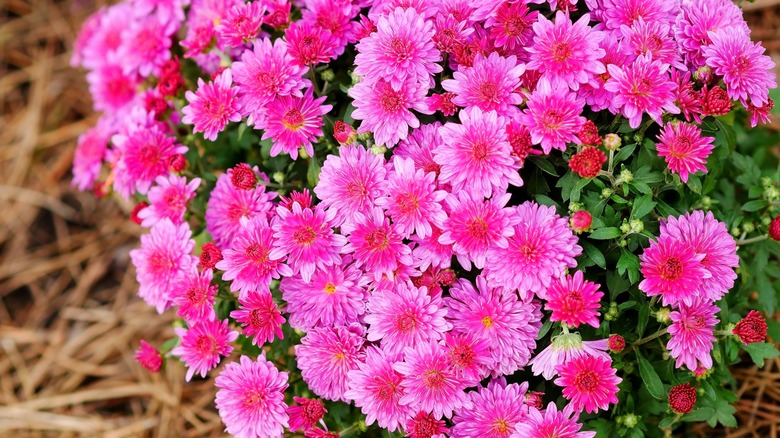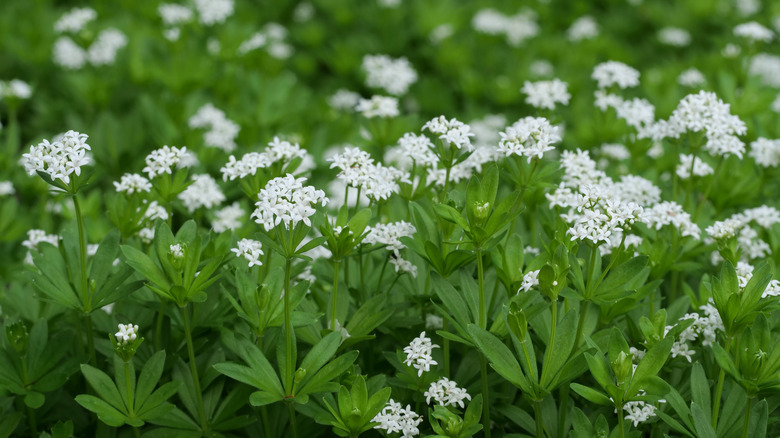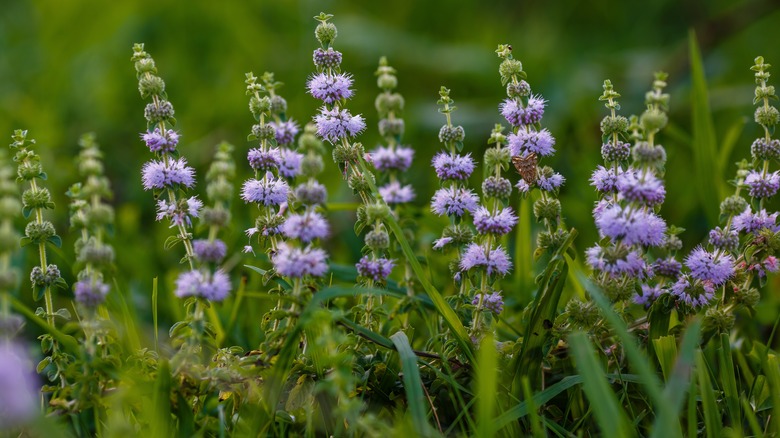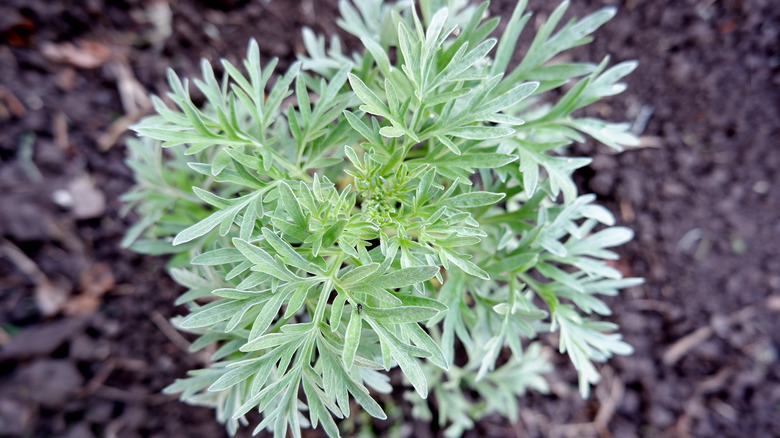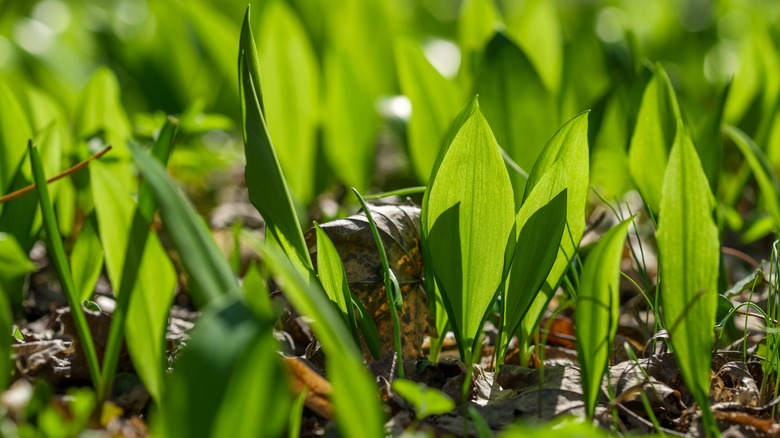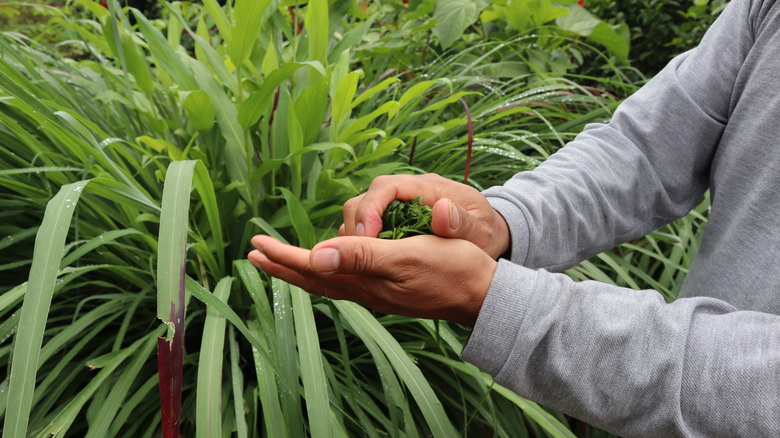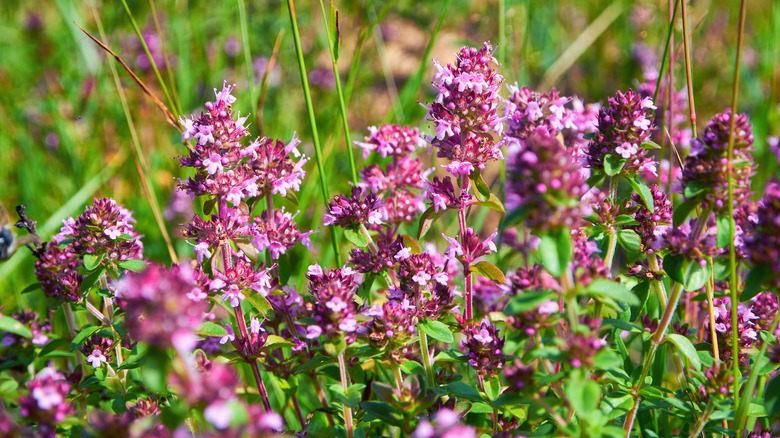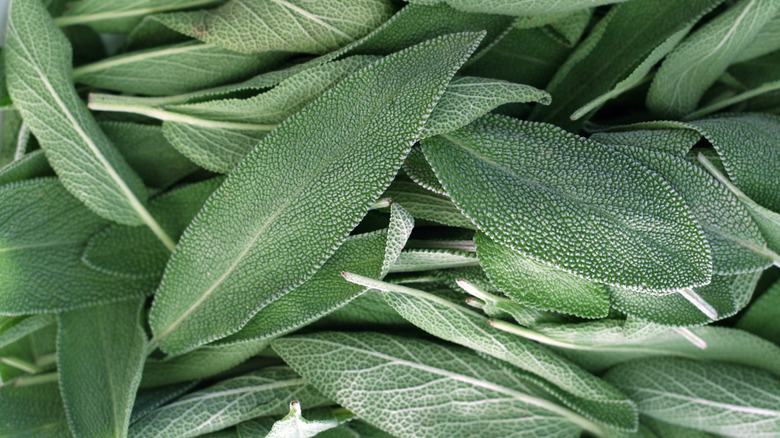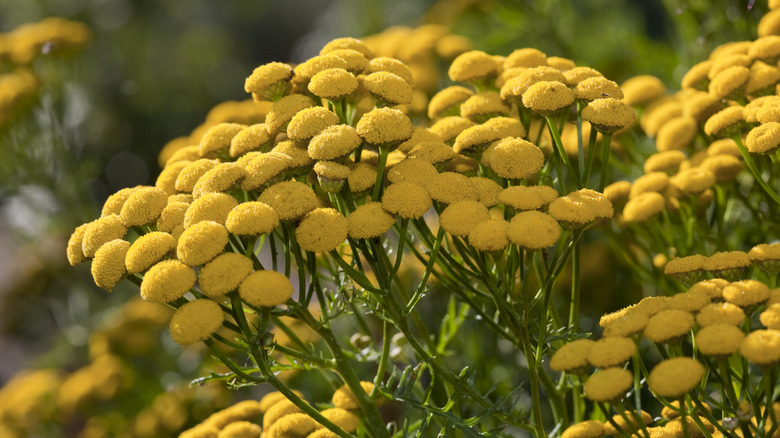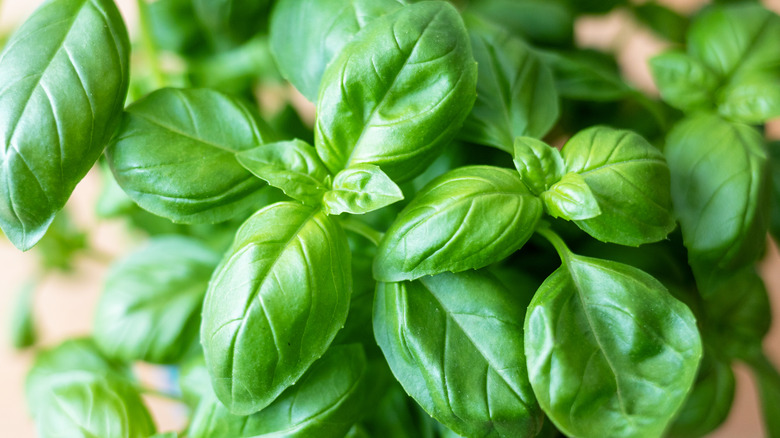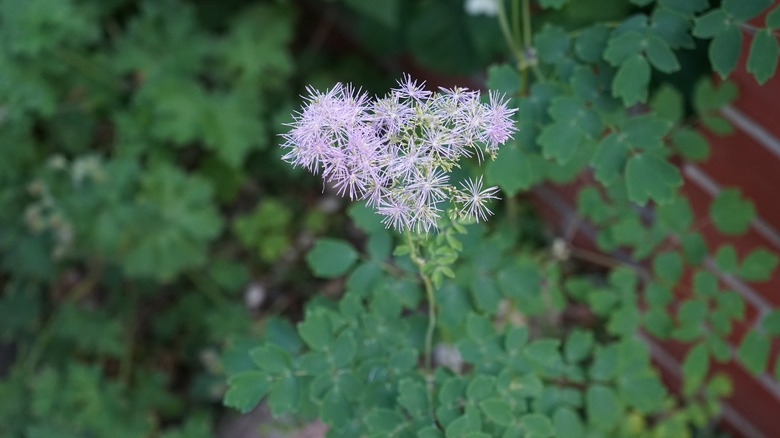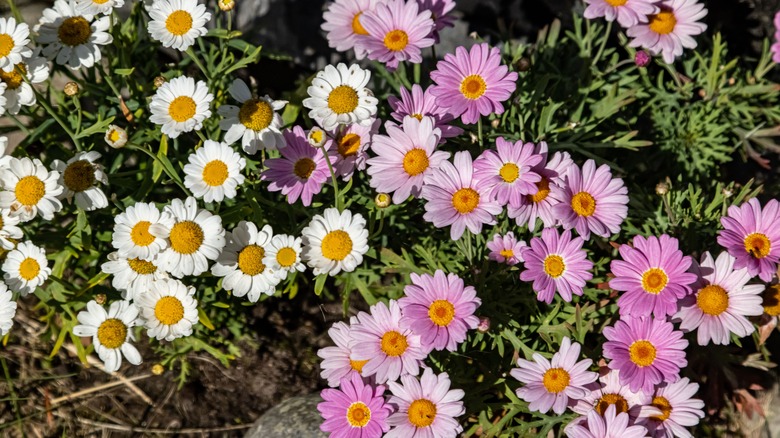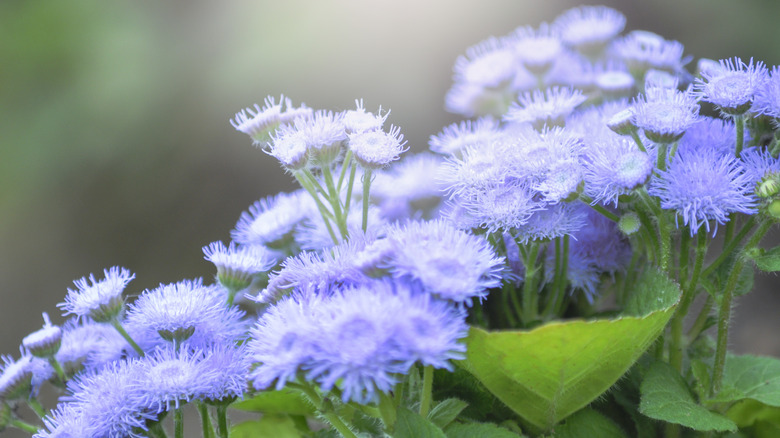Keep Pesky Ticks At Bay With The Help Of These 22 Beautiful Plants
While no plant can completely eliminate ticks, some are believed to repel these pests. This is important because keeping ticks away from your yard is essential. First and foremost, ticks are vectors of severe diseases, like Lyme disease, Rocky Mountain spotted fever, and anaplasmosis. These can have serious health consequences for both humans and pets. Preventing tick infestations in your outdoor spaces reduces the risk of exposure to these diseases, making everyone safer.
Yet not everyone wants to go the chemical route to keep them at bay. Instead, they reach for beautiful plants to get the job done naturally. Unlike chemical pesticides, which can have unintended negative impacts on non-target species, plants repel ticks without causing ecological imbalances Plus, relying on plants promotes a healthier ecosystem by attracting beneficial insects that prey on these pests, contributing to a more balanced and resilient garden environment. This approach aligns with sustainable gardening practices that prioritize long-term harmony between nature and humans. When you use plants to keep ticks at bay, you're safeguarding your yard and personal health. You're also supporting a more environmentally conscious and healthier outdoor space for all living organisms.
1. Lavender
Lavender smells and looks fantastic with its soothing aroma and delicate purple blooms. However, while it is doubly appealing to humans, the plant is a huge deterrent to ticks. The secret lies in its powerful scent. The species of lavender known as true lavender has high concentrations of linalool and linalyl acetate, which ticks find repulsive. As the plant secretes these oils and they are diffused through the air, most will steer clear of the area.
While you can have some luck keeping ticks away with a gorgeous blooming lavender plant, you are guaranteed more success with a fresh lavender essential oil, as the smell and concentration of the linalool and linalyl acetate will be greater. You can combine the oil with water in a spray bottle and mist the areas you are concerned about. You can even spray it around the lavender plants for double the tick protection in your garden.
2. Rosemary
Rosemary is often used in cooking because it smells fantastic and has a subtle taste that really warms up a dish. However, for the palette of a nasty tick, the effect is the exact opposite. Rosemary is infused with some naturally potent oils. They are known as cineole and camphor, and they form a natural barrier around the plant that ticks find uninviting. The scent shield not only keeps them away from rosemary, but also makes the general vicinity less appealing, too.
While results can differ based on factors like concentration and environment, rosemary has exhibited a commendable track record in fending off ticks, proving that its charm extends beyond the kitchen. New research suggests that the Spanish variety of rosemary might be the best at keeping ticks away. In fact, it might even be as good as chemical options like DEET at fending off the little intruders.
3. Lemongrass
Lemongrass smells great and has a zesty element that appeals to many human noses. This is why it is often found in gardens. However, the plant serves a double purpose of keeping ticks away from our homes. This is because it has a high concentration of citronella oil in it. Studies suggest that Brown Ear Ticks are mainly put off by the oils coming off lemongrass and tend to stay away. While this tick is more commonly found in livestock in southeast Africa, more research is ongoing to understand the impact of lemongrass on all tick species.
However, in initial studies, this fragrant defense mechanism has shown significant promise in deterring ticks from making their homes where humans don't want them to be. To make it even more potent, trim it regularly to release its scent into the yard, warding off any hungry pests. Just make sure to plant it in the ground inside a container, or else it might take over your yard.
4. Peppermint
Who doesn't love peppermint? Luckily for your yard, ticks hate it. Peppermint has an invigorating scent and cool essence, making it a formidable contender in the realm of tick prevention. This is because of the fragrant active compounds in peppermint plants, like menthol and pulegone. The chemicals release a potent fragrance that ticks find overwhelmingly displeasing, so they stay away from it. One thought is that the smell confuses and overwhelms the ticks' senses, making them disoriented. It becomes paralyzed by the smell, as the scent takes over the organ on its legs it uses to navigate.
Peppermint plants are perennial, which means they come back and keep growing year after year. They also tend to grow aggressively, making them easy to care for. Because of this, even beginner gardeners can rely on peppermint plants to keep their yards safe from ticks without too much work. However, plant them in containers, or they will spread across your entire yard.
5. Oregano
If you want to grow herbs for cooking while protecting yourself from ticks, reach for oregano. The lush green, leafy herb is a beautiful addition to any garden as it has a great taste — but one which ticks hate. There are two essential oils in oregano: carvacrol and thymol. Much like other essential oils in plants, this pair releases an aromatic shield that seems to repel ticks. Using this fragrant ploy can disrupt the tick's sensory perception and make the area less inviting for them to live in. They can't find their way around, and it is assumed they then can't find food sources. Then, they likely die out. This keeps your yard and family much safer.
If you don't want to use the leafy version of oregano, reach for the concentrated oil instead. You can place it around the edges of your yard, flowerbeds, and even patio for the same effect.
6. Eucalyptus
Native to Australia but loved around the world, eucalyptus is known for its majestic presence and distinctive aroma. Yet the flowering tree has another amazing quality: It has a remarkable talent as a tick deterrent. The active compound found abundantly in its leaves is called eucalyptol. This compound emits a full-bodied scent that disrupts the sensory receptors of ticks, steering them away from its vicinity. They get confused and can't find their way, meaning they won't sneak into spaces where you don't want them.
Like most plants, eucalyptus is most effective against ticks in its distilled oil form. However, the tree does seep oil into the atmosphere around it. In areas with large amounts of trees, you can see this phenomenon with the naked eye, as the valley appears to be covered in a blue haze. So, eucalyptus serves as a prime example of nature's pest-fighting arsenal, offering both visual splendor and practical tick-repellent properties.
7. Lemon balm
Lemon balm trees smell fantastic to the bare human nose. They look beautiful, too, as their heart-shaped leaves tend to be a waxy, lush green that makes a real visual statement. However, amid the delightful citrus fragrance emerges a fascinating ally in the battle against ticks. The trees are rich in compounds like citronellal and geraniol, so lemon balm exudes a scent that repels ticks and thwarts their presence. This aromatic shield creates an environment unfavorable for these pests, making it an attractive choice for natural tick prevention. You can even rub the crushed leaves directly onto your body to prevent bites.
While the exact success rate can vary based on factors like concentration and location, lemon balm's reputation as an effective tick deterrent is gaining traction. If you are trying to naturally deter ticks without hurting other species in your yard, it is a great option as the plant also actively encourages the presence of bees.
8. Marigold
Marigolds are beautiful flowers with vibrantly colorful blooms. The flower has a pleasant, earthy aroma to humans, but ticks tend to hate the scent and have been known to stay away. The natural compounds present in marigolds, including thiophenes and pyrethroids, release a scent that ticks find repulsive. This aromatic defense mechanism interferes with their sensory receptors, discouraging their presence. In fact, pyrethroids are often used in many chemical insect repellants. However, research is still emerging on their effectiveness, but it's worth a shot.
Marigolds are also considered particularly easy to care for and rebloom each year. So even beginner gardeners (or seasoned pros who don't have the greenest thumbs) will find the flower's upkeep easy enough to handle. Plus, they're also known to repel other annoying pests, such as mosquitos and cabbage worms, but attract beneficial insects like ladybugs. This will create a harmonious balance in your garden. They're also great companion plants, so plant them next to your tomatoes and cucumbers to keep pests away.
9. Chrysanthemum
Chrysanthemums have large, unfolding blooms in many colors, from bold reds to bright yellows, sweet pinks, and creamy whites — the flower has it all. Chrysanthemums are a highly desirable, attractive addition to any garden. However, the flower isn't just known for its colorful blooms. It also holds a powerful secret as a natural tick repellent. The compound pyrethrin, which is extracted from chrysanthemum flowers, disrupts the nervous systems of ticks and insects upon contact, leading to paralysis and eventual death.
This potent botanical defense mechanism has been harnessed for its insecticidal properties for decades. Chrysanthemums' efficacy in repelling ticks is well-documented, and their extracts are widely used in various pest control products. Their effectiveness, coupled with their relatively low toxicity to humans and pets when used properly, underscores chrysanthemums' importance as a reliable and eco-friendly option in the ongoing battle against ticks and other pests. You get to have a beautiful, tick-free flowerbed. It's a win-win.
10. Catnip
Catnip, famed for its captivating effect on felines, holds another intriguing quality as a natural tick repellent. The plant has high concentrations of the compound nepetalactone. This organic compound, which is famous for its euphoric response in cats, is now also known for its remarkable ability to repel ticks from yards and outdoor spaces. The reason nepetalactone acts as a potent tick deterrent is due to its strong aroma and chemical properties. Studies have shown that nepetalactone can interfere with the sensory receptors of ticks, deterring their attraction to the area where catnip is present.
As a result, planting lots of catnip in your yard can reduce tick populations, providing a chemical-free and environmentally friendly solution to tick control. This natural approach not only offers a safer alternative to conventional pesticides, but also adds a touch of greenery and tranquility to outdoor spaces, benefiting both humans and their feline companions.
11. Sweet woodruff
Sweet woodruff is celebrated for its delicate white flowers and sweet scent. Visually, it is a great addition to any garden. Surprisingly, this gorgeous plant is also emerging as a noteworthy contender in tick prevention. The plant contains coumarin, a natural compound that releases a subtle yet distinctive aroma that ticks find unappealing. This aromatic barrier disrupts their sensory perception and creates an environment they'd rather avoid. Recent studies focus mainly on coumarin as an insecticide in instances of mosquito larvae in particular. Still, scientists are also interested in how the chemical kills all larvae — regardless of species.
While some evidence suggests that coumarin possesses repellent properties against ticks, its efficacy in tick control is not as well-established as other compounds. However, by planting sweet woodruff, you can employ a subtle yet effective (if novel) strategy to keep ticks at bay. The flowers will not harm your garden or pets and can only do good.
12. Pennyroyal
Pennyroyal is a resilient herb that has been used for centuries in both food and medicine. In more recent years, a new use for the traditional plant has emerged: a potent contender in the realm of tick avoidance. Pennyroyal is an herb deeply enriched with compounds known as pulegone and menthone. These are essential oils released from the plant that carry an intense minty fragrance. Ticks find this smell exceedingly unappealing. Like many other natural pest solutions, pennyroyal creates an aromatic barrier that interferes with their sensory perception, deterring them from colonizing the area.
The flower is beautiful, often blossoming with bright pink and blue flowers in the springtime. Amid the bloom, the human nose can pick up the plant's strong, minty scent. It's strong enough that even passersby can enjoy it. Because of its strong aroma and visual appeal, it is a gorgeous plant that you can be sure is working around the clock to keep ticks out of your yard.
13. Wormwood
A great way to keep ticks out of your yard is to ward off the animals that introduce them in the first place. If you want to keep deer with ticks out of your yard, plant some wormwood. The plant is attractive, as its slender leaves mimic the unique sprawl of snowflakes, but it has a strong smell that deer and ticks don't like. The scent results from the presence of essential oil compounds like thujone and artemisinin, which are highly present in the plant.
While wormwood is toxic to ticks, it can also be toxic to pets and humans if ingested. Be sure to keep your dogs, cats, and kids away from the wormwood if you have it in your yard. The plant is also known to cause skin irritation in some when handling it, so keep a pair of gloves on if you spend too much time touching this perennial.
14. Garlic
Garlic is usually a vegetable that is used in the kitchen to add flavor to meals. However, if you were to grow garlic in a backyard garden, it's also possible to help keep ticks at bay. This is because the sulfur compounds that give garlic its pungent aroma, like allicin, create an environment that ticks find displeasing. This aromatic defense mechanism interferes with their sensory receptors and deters their presence. If you or your pet eats garlic, it will have much the same effect. If you eat a clove a day, it should repel pests from feeding on you.
However, plant garlic into the ground if you want to feel safer when working in the garden by knowing that the high grass isn't a threat because fewer ticks are lurking. The plant also has the bonus of being a rather attractive addition to a garden, as its tops tend to blossom into bright purple flowers that attract the kind of bugs you want in your yard.
15. Citronella grass
Citronella grass has quite the reputation as an effective natural deterrent against ticks in yards. This is because the grass has a high citronellal concentration, a prominent aromatic compound. The strong and distinctive scent of citronella, which is released when the grass is crushed or brushed against, acts as a powerful repellent against lots of insects, which luckily includes ticks. The volatile nature of citronellal disrupts the ticks' sensory receptors, making it challenging for them to locate hosts or breeding grounds. If they can't eat or reproduce, they will eventually die out in the area.
Plus, because of its deep green and wispy appearance, citronella grass adds aesthetic value to outdoor spaces. This enhances the appeal of yards while simultaneously serving as a natural shield against ticks. By planting citronella grass or using citronella-based products, homeowners can create a protective barrier that discourages ticks from inhabiting the area, providing an eco-friendly and non-toxic method of tick control.
16. Thyme
Planting thyme can get rid of ticks in a hurry. The herb has long been cherished for its culinary and medicinal applications; however, if you grow some in your garden, you are also taking a step against tick prevention. These are a few essential oils found in thyme that work well to confuse and overwhelm ticks. The most notable are thymol and carvacrol.
When eaten or crushed (or walked on as a tiny little tick), these oils will thoroughly coat ticks' small leg hairs. They use their legs to sense the world around them, as they are essentially blind and deaf. So if the sensors are coated in an oil with a strong smell, the ticks become overwhelmed and become immobilized. So, whether planted in gardens or used as essential oils and spritzed around your patio, this lush, leafy plant is a great natural way to keep ticks away.
17. Sage
Sage plants contain plenty of different aromatic compounds. This is why the plant smells so good to humans. But these same compounds make it an excellent tick-repellent. The most powerful compounds are thujone and camphor, which give sage its distinct scent. When the leaves are crushed, or even just touched by something as small as a tick, they release these oils into the air. This makes the environment unfavorable for ticks. It prevents their ability to communicate, so they can't eat or find a host to bite and burrow into. If they can't do these things, they will die.
Research is still ongoing into the overall impact that sage can have on ticks and other pests like fire ants. However, by incorporating sage plants into landscaping or using sage-based repellent products, homeowners can harness the plant's natural tick-repelling properties to provide a safer and more pleasant outdoor space without relying on harmful chemicals. As a bonus, the plant looks great.
18. Tansy
Tansy is a popular flower to have in your garden because it is beautiful, bright, and yellow. The perennial flower is known to thrive in most parts of Europe, Asia, and North America. Aside from providing great visual interest to a yard, these yellow clusters of flowers hold a lesser-known but significant role as a natural tick repellent. Studies suggest that the petals have high concentrations of the essential oils thujone and camphor. While the oils do best to repel ticks in their distilled forms, there might also be enough oil on the flowers to keep ticks at bay.
The oils present in tansy flowers work much in the same way as other natural tick repellents. When they coat the sensory preceptors on a tick's legs, they find the potent aroma repulsive. The ticks are immobilized since their sensory preceptors are knocked out. However, it's essential to note that tansy contains toxic compounds and should be used cautiously, especially around pets and children.
19. Basil
Basil is more commonly used in cooking due to its strong flavors; however, if you have an herb garden, you can use it for more than just an addition to dinner. Much like other plants that repel ticks naturally, basil has a few compounds that overwhelm ticks' senses and immobilize them. In this case, the compounds are eugenol and citronellol. In addition to keeping grown ticks away from the plant, studies also show that eugenol oil is effective at killing tick larvae, too. While the study found that the oil impacts certain types of ticks more than others, using it is a great step towards a tick-free, chemical-free lawn.
Basil is easy to care for and grows easily, meaning that even beginner gardeners can take advantage of the plant's tick-repellent properties without too much planning or daily care. The plant likes to stay consistently moist and likes sun, but doesn't want to be blasted by full sun. As long as you keep those requirements in mind, you will have a healthy and happy plant.
20. Rue
Rue is an herb with a storied history of both medicinal and magical uses. You might also hear it called common rue or herb-of-grace. While the plant originates from the Balkan Peninsula, it is famous around the world because of its bright flowers and pretty bluish leaves. It is an easy plant to care for as it doesn't require much water or care. In the modern age, it also stands out as a potent repellent for ticks. Rue leaves have quite a strong smell, which many pests don't like and tend to stay away from, including ticks.
While no scientific studies have officially been conducted to test the plant's efficacy, many gardeners anecdotally recommend the plant as a line of defense. However, it's important to note that rue contains compounds that can be toxic in high amounts and particularly harm pregnant women, so be careful not to ingest it, even though you want the ticks to.
21. Pyrethrum
Pyrethrum is a type of flower derived from the dried flowers of Chrysanthemum species. They are sometimes called Dalmatian Daises. The flower is an amazing way to keep ticks out of your garden without using any chemicals. This is because of the key active compounds found in pyrethrum, known as pyrethrins. These compounds have a specialized mechanism of action that targets the nervous systems of ticks and insects. When exposed to pyrethrins, these pests experience rapid paralysis and eventual death. While it can be lethal to insects and ticks, its toxicity to humans and pets is relatively low.
The historical use of pyrethrum as an insecticide dates back centuries, with cultures around the world harnessing its potency. This historical knowledge underscores the long-standing understanding of its efficacy in pest control. Over time, this natural solution has been refined and incorporated into various pest control products, from sprays and powders to shampoos and even pet treatments.
22. Floss flower
Floss flower, scientifically known as ageratum, has emerged as a surprising contender in the realm of natural tick prevention. Although the plant is primarily cherished for its vibrant violet-blue blooms, floss flower also contains a compound called coumarin. This compound releases a fragrance that ticks find unappealing. This aromatic defense mechanism disorients the ticks, eventually killing them. However, to humans, the scent of the compound is actually quite pleasant, even being used in perfumes.
While floss flower's efficacy as a tick repellent is not as widely studied as other plants, its potential is intriguing, as it has been known to repel mosquitos. Because of this, its use as a natural option for getting rid of ticks as well is gaining attention in the gardening community. Floss flower showcases the diversity of nature's strategies in deterring pests, offering a visually appealing and fragrant approach to keeping ticks at bay.
